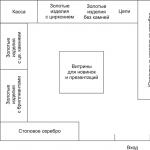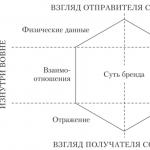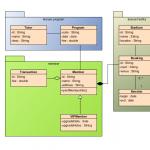How to correctly parse a sentence. What is parsing
v parsing compound sentence(SSP)
Parsing plan:
2. Find boundaries simple sentences as part of a complex one, draw up a BSC diagram.
- by the type of complex sentence - compound (CSP);
- indicate which coordinating union connects simple sentences as part of a complex one;
1 [You are many years late], but 2 [still I am glad to see you] (A. Akhmatova)
Offer scheme:
The sentence is declarative, non-exclamatory, complex, compound, consists of two simple sentences connected by the conjunction NO with the meaning of opposition; a comma is placed before the union but.
v syntactic analysis of a complex sentence (CSP)
Parsing plan:
1. Underline the main members of the sentence (subject and predicate) and indicate how they are expressed (what part of speech).
2. Find the boundaries of simple sentences as part of a complex one, draw up an NGN diagram.
3. Describe the proposal:
- according to the purpose of the statement - narrative, incentive, interrogative;
- by intonation - exclamatory, non-exclamatory;
- by the number of bases - complex;
- by the type of complex sentences - complex subordination (CSP);
- indicate the number of simple sentences in the complex;
- indicate which union or allied word connects simple sentences as part of a complex one;
- view subordinate clause- explanatory, attributive, adverbial (with subtypes);
- Explain punctuation.
An example of how to parse a simple sentence:
1 [The boys looked after the truck], 2 (until he drove off the intersection).
Offer scheme: ![]()
The sentence is narrative, non-exclamatory, complex, complex, consists of two simple sentences, the first simple is the main one; simple sentences as part of a complex one are connected by the allied word BYKA, this is a NGN with an adverbial adverbial measure and degree. There is a comma between the first and second simple sentences.
v parsing complex unionless proposal(BSP)
Parsing plan:
1. Underline the main members of the sentence (subject and predicate) and indicate how they are expressed (what part of speech).
2. Find the boundaries of simple sentences as part of a complex one, draw up a BSP diagram.
3. Describe the proposal:
- according to the purpose of the statement - narrative, incentive, interrogative;
- by intonation - exclamatory, non-exclamatory;
- by the number of bases - complex;
- by the type of complex sentences - unionless (BSP);
- indicate the number of simple sentences in the complex;
- indicate the means of communication of simple sentences as part of a complex one - a semantic or intonational connection;
- Explain punctuation.
An example of how to parse a simple sentence:
Our conversation began with slander: I began to sort out our acquaintances present and absent.
Offer scheme: ![]()
The sentence is narrative, non-exclamatory, complex, non-union, consists of two simple sentences, interconnected in meaning; a colon is put in the sentence, since the second part of the BSP indicates the reason for what is said in the first part.
When working with various texts, many need to parse a sentence according to its composition. The implementation of such an analysis usually assumes that a person has the appropriate philological knowledge that can help in the correct analysis of the text he needs. At the same time, there are also services in the network that perform online sentence parsing operations. After a thorough study of the rules for parsing different offers In terms of composition, I decided to present all my achievements in this article.
At the beginning, I note that the expression “parsing a sentence by composition” is somewhat incorrect, since words are usually parsed by composition, and what we are interested in in this case is called “syntactic analysis of a sentence”.
At the same time, the specified parsing (in school it is also called “parsing by members”) is usually performed as follows:
- Decide which sentence to be analyzed according to the purpose of his statement (declarative, interrogative, or has an incentive character);
- Indicate the emotional coloring of the sentence (it is exclamatory or not exclamatory);
- Mark the number of grammatical bases in this sentence (if the sentence is simple - then one basis, if complex - two or more);
If the sentence is simple:

Simple sentence example:
“It was an extraordinary autumn day!”
After parsing, we can see that this sentence is declarative, exclamatory, simple, two-part, complete, not complicated.
If the sentence is complex:
- Decide on the connection in a complex sentence - allied or non-union;
- Indicate the connection used in the sentence - intonation, subordinating, coordinating;
- Indicate the type of complex sentence - non-union, compound, compound.
Complex sentence example:
"There were roses and lilies in the bouquet, but she liked tulips more."
After syntactic analysis of this sentence, we can see that this sentence has a narrative character, is not exclamatory, complex, has allied connection, compound. The first sentence here is two-part, the grammatical basis is the words “roses and lilies were”, it is common, and complicated by homogeneous subjects.
The second sentence in this complex sentence is two-part, its grammatical basis is the words “I liked tulips”, the sentence is common and not complicated.
Services for parsing proposals by composition online
Due to the richness of grammatical structures, and the complexity of creating a powerful network tool for parsing text, the services presented on the network (of which there are few) have rather weak capabilities for conducting a full-fledged parsing of sentences. However, I would highlight the following resources:
Seosin.ru
Among the Russian-language resources for online semantic analysis (de facto, they are practically not represented), I would single out the seosin.ru service. It allows you to identify syntactic and morphological errors, demonstrates the general associativity of the text, and performs other types of analysis. Unfortunately, the service does not always work stably; dysfunctions are often observed in its work.
- To work with this service, go to the site seosin.ru.
- Enter your proposal in the appropriate box, and click on "Analyze".

Lexisrex.com
lovers of English language the powerful linguistic resource lexisrex.com can help with parsing. Its capabilities allow you to analyze the proposal by its members. At the same time, this site also has other auxiliary tools for performing various types of linguistic analysis online.
- To access this resource, please log in to lexisrex.com.
- Paste your proposal into the appropriate box and click on the "Analyze" button.

Forums of linguists
In syntactic parsing of a sentence online, you can turn to the help " human factor”, and go to various forums of linguists (level gramota.turbotext.ru, rusforus.ru and analogues). Register there, ask your question, and they will definitely help you.

Conclusion
Network resources that allow analysis of proposals by composition are rather scarce, which is associated with the difficulties of creating such resources. However, there are several such tools on the web (most of them are in English) that make it easy to carry out the text analysis we need. Use the functionality of these services to parse the necessary sentences and parse them online.
In contact with
Parsing a sentence by composition is called syntactic. He is one of the first to be studied in school. At first, the process can be difficult, however, after two analyzes, many people quickly find all the components. Knowledge of parts of speech, rules about the basis and secondary members of a sentence, understanding the connection of words in a phrase will help in parsing. It's coming to an end elementary school, so students in grade 5 perform analysis without difficulty.
By following a certain sequence, you can quickly make an analysis. To do this, you need to pay attention to the following steps:
- Determine what type the phrase belongs to: narrative, interrogative or incentive.
- According to the emotional color, exclamatory and non-exclamatory sentences are distinguished.
- Then they move on to grammar. It needs to be found, to indicate the way of expression, to indicate whether the sentence is simple or complex.
- Determine the one-part and two-part written.
- Find additional members of the sentence. They will show if it is common or not.
- With the help of certain types of lines, highlight each minor member of the sentence. At the same time, above the word indicate what kind of member of the sentence it is.
- Indicate whether there are missing members of the sentence in the proposed phrase, which will determine whether the statement is complete or incomplete.
- Are there any complications?
- Describe what is written.
- Make a diagram.
To correctly and quickly parse, you need to know what the basis and minor members.

The foundation
Every stem has a subject and a predicate. When parsing, the first word is underlined with one line, the second - with two. For example, " The night has come". Here the grammatical basis is the full phrase. It has the subject word "night". The subject cannot be in any other case than the nominative.
In the neighborhood is the predicate "came", which describes the action performed with the subject. (Dawn has come. Autumn has come.) Depending on whether the sentence is simple or complex, one or two bases are distinguished. In the statement " Yellow leaves fall from the trees” one grammatical basis. And here are two basics: "The moon hid - the morning has come."

Before parsing phrases, you need to find additional members of the sentence:
- Most often, the object is a noun or a pronoun. Prepositions can be added to the second member of the sentence. It answers all questions of cases. This does not include the nominative case, since only the subject can have it. Look (where?) At the sky. Let's discuss the (what?) question. In semantic meaning, they are on the same level as the noun.
- The definition performs a descriptive function, answering the question “Which one? Whose?". It is often difficult to identify a member of a sentence due to the fact that it can be of two types. Agreed when two words are in the same person, gender, number and case. Inconsistent acts as a phrase with control and adjacency. For example: "Hanging on the wall bookshelf. There is a shelf for books on the wall. In both cases, one can ask the question: which one? However, the difference is the consistency and inconsistency of the definition.
- The circumstance describes the manner of action, the time. It is considered the most extensive member of the proposal. We met (where?) at the store. (When?) We went to the cinema yesterday. I (how?) will easily do the exercise. This leads to the fact that the circumstance is often confused with the addition. Here it is important to correctly put the question from the main word to the dependent.

Relationship while writing
It is important to say that all minor members are necessarily associated with one of the main words. The definition is part of the subject, so questions are asked from this member of the sentence. But the addition and circumstance are connected with the predicate.
When parsing, the secondary members should be indicated on the letter. If the subject and predicate are underlined with one and two lines, respectively, then the addition is highlighted with a dotted line, the definition with a wavy line, the circumstance with a dot and a dash. When parsing, it is necessary to indicate in a graphical version what each word is.
Practical lesson
Consider a simple sentence:
In winter, tourists go to the ski resort.
Start from the basics. Here it is represented by the phrase "tourists are leaving." That is, the subject is tourists, the predicate is sent. This is the only basis, so what is written is a simple statement. Since there are additional members, it is common.
Now you can start looking for add-ons. It was not used here when writing. It is followed by a definition: to (which?) ski resort. And you can highlight the circumstances. They go (where?) to the resort, they go (when?) in winter.
This is how the sentence looks like when parsed by composition: In winter (obst.) tourists (subl.) go (sk.) to a ski (def.) resort (add.).

Complex sentence example:
The sun went behind a cloud, a light rain fell from the sky.
First we look for the base. The sentence is about sun and rain. So, there are two bases in the sentence: the sun has set, and the rain has begun. Now we need to find additional members of the sentence in each basis. Went (where?) behind a cloud; went (what?) small, went (where?) from the sky.
This is how you need to parse common sentences by composition:
The boy sat on the roof of the house and looked at the starry sky, attracting the eye.
(Descriptive, non-exclamatory, simple, two-part, common, complete, complicated by homogeneous predicates and separate definition, expressed participle turnover).
Here the basis is - the boy sat and watched, therefore there are two predicates. We find the secondary members of the sentence. Sat (where?) on the roof (what?) of the house. He looked (where?) at the sky, (what?) starry. The sky (what?), eye-catching.
That is, after finding all the components of the statement, it will look like this:
The boy (subl.) sat (sk.) on the roof (obst.) of the house (adv.) and looked (sk.) at the starry (def.) sky (obst.), attracting the eye (def.).
Parsing making suggestions is easy. The main thing is to follow the steps, starting with the search for the main members of the proposal. They are the foundation. Then they move on to secondary ones. At the end of the analysis, each of them is underlined with a certain line.
Video
From the video you will learn how to properly parse a sentence.
Didn't get an answer to your question? Suggest a topic to the authors.
Syntax is the most complex section of the modern Russian language. At school, the syntactic analysis of a sentence almost always causes serious difficulties, since in the analysis it is necessary to use the previously acquired knowledge in a complex way: to be able to distinguish parts of speech, access information from the vocabulary, to navigate perfectly in the semantic load and functions of different members of the sentence, to correctly indicate simple sentences in the composition complex and define their role.
At school and university are presented different requirements to the syntactic analysis of the sentence. Schoolchildren usually designate parts of speech, and comment on each word during analysis. The requirement is due to the fact that for correct parsing it is necessary to know morphology well, the concepts of syntax and morphology should not be confused (there is a common mistake when parts of speech and members of a sentence are mixed). At the philological faculties of various higher educational institutions parsing schemes are individual: it depends on how educational complex undergoing training, which are methodological developments at the department. When preparing for admission, the applicant will need to find out the requirements of a particular university, otherwise the analysis may be considered incorrect.
To correctly parse a sentence, you need to master a large amount of theory, be able to accurately use terms, and gain practical skills. Practice plays a particularly important role, so it is advisable to train regularly by analyzing sentences. different levels difficulties.
Strict requirements are imposed on parsing: it can only be done according to a clear scheme, without deviating from a given algorithm. Often it is also necessary to draw a graphic scheme of the sentence, reflecting in it the levels of division, the dependence of simple sentences on each other. Also, the members of the proposal are graphically highlighted different signs directly in the text (several types of subscripts).
General scheme for parsing a sentence
Exists general scheme, on which the syntactic parsing of the sentence is carried out. It varies depending on specific requirements, but the basic base remains the same.
- The purpose of the statement is indicated: declarative, motivating, interrogative sentence.
- On the this stage you should write what the sentence is in terms of intonation: exclamatory or non-exclamatory.
- The type of sentence is determined: simple or complex, consisting of several simple ones.
- For complex sentences, you need to specify the type of construction: simple (of the same type), complex ( different types connections between simple sentences in a complex one).
- The type of connection of proposals is indicated: allied, allied.
- There are two types of allied sentences: compound and complex.
- For a complex sentence, the type of the subordinate clause is determined: attributive, explanatory, adverbial, adjunctive;
- It is necessary to indicate the type of adverbial clause:
- mode of action;
- places;
- time;
- terms;
- measures and degrees;
- comparisons;
- concessions;
- consequences;
- goals;
- the reasons.
- mode of action;
- If the sentence is complex, a description of the connection of parts in the complex is performed. The parts are numbered, all types of communication are indicated (unionless and allied, subordinating and coordinating), if necessary, division into levels is made.
- Then they proceed to the characteristics of each simple sentence, indicating its number.
- The analysis of a simple sentence continues to indicate the presence of main members: one-part or two-part.
- In a one-part sentence, its type is determined: nominal, generalized-personal, impersonal, definite-personal or indefinitely-personal.
- At this stage, you need to write the type of predicate: PGS (simple verbal predicate), CGS (compound verbal predicate) or SIS (compound nominal predicate).
- Now it is necessary to determine the presence of minor members: common (there are minor members), non-common (there are no minor members).
- At this point in the analysis, it is indicated whether the sentence is complicated, what exactly it is complicated by.
- At the end of the analysis, it is necessary to determine the type of sentence in terms of completeness: complete or incomplete. Incomplete sentences are those in which the main or secondary members are omitted, but they can be easily restored from the context.
Ways of expressing sentence members
Knowing how to express the members of a sentence will help you parse the sentence correctly without confusing parts of it. Often, school students find it difficult to even determine the main members of a sentence, since there are a number of difficulties, and generally accepted stereotypes make it difficult to correctly find the basis and accurately analyze the secondary members.
It must be remembered that different parts of speech have practically unlimited possibilities and can be almost any part of the sentence, with rare exceptions. Often, students get used to the fact that the subject is a noun, and the predicate is a verb. Not seeing the appropriate parts of speech in a sentence, they find themselves in a difficult position and do not know how to parse it by composition. In fact, it is impossible to conclude analysis in such a framework.
Subject answers questions of the nominative case and is expressed different parts speech: nouns, pronouns, numerals. The subject can also be expressed:
- adjective (red is my favorite color);
- a participle that has turned into a noun (the others were silent);
- union (and - connecting union);
- an indefinite form of the verb (for example, an indefinite form of a verb with a noun in the accusative case: having a doctor in the house is a serious advantage).
To differentiate different types predicates, it is important to remember the lexical and grammatical meaning of words. Lexical meaning reflects the meaning of the word, and grammatical contains grammatical categories(for example, mood, tense, number and gender of the verb). Types of predicates:
- PGS: the predicate is expressed in the personal form of the verb, in which the GZ and LZ coincide. Sometimes PGS is expressed by a phraseological unit containing a conjugated verb form.
- GHS: Must consist of at least two words. Each word has its own meaning: the infinitive of the verb ( lexical meaning) and modal or phase connective ( grammatical meaning). The phase link indicates the phase of the action, and the modal link reflects the attitude towards the action. The link can be expressed in words reflecting the assessment of the action, desirability, necessity, short adjectives.
- SIS: must consist of at least two words. Nominal part (LZ) and formal or semi-significant copula (GZ). A more common formal link is the verb to be. All nominal parts of speech, adverbs, phrases act as a nominal part. Semi-significant connectives are verbs to become, to become, to be, to seem, and others; verbs of state, movement.
- The agreed definition is easy to recognize, it is expressed by a pronoun-adjective, adjective, participle, ordinal number. The main thing is not to confuse it with the nominal part of the SIS.
- An inconsistent definition is usually expressed by nouns in indirect cases, but sometimes adverbs, phrases, infinitives, adjectives become them. comparative degrees. There are also inconsistent application-definitions.
Circumstance answers to general question as? Expressed by adverbs and nouns. Circumstances are divided into categories:
- circumstance of time;
- places;
- mode of action;
- the reasons;
- comparisons;
- concessions;
- terms;
- goals;
- measures and degrees.
Types of subordinate clauses
Analyzing complex sentence, it is important to correctly determine the type of the subordinate clause. It can be circumstantial, explanatory and attributive.
- Subordinate explanatory sentences answer the questions of indirect cases. Unions, allied words act as means of communication.
- Subordinate attributive clauses refer to a noun, join with the help of allied words, sometimes unions, answer the questions of whose? which?
- Adverbial adverbial clauses differ depending on the category:
- PO places answer questions where? where? where? join with allied words;
- How long do they answer questions? how long? when? for how long? Joining with the help of unions is common only, when, bye, as soon as, etc .;
- ON measures and degrees answer the questions to what extent? how much ?, refer to a word expressing a concept that can have a degree of manifestation;
- The software of the mode of action answers the question how ?, you can insert words into the main part in this way, so;
- ON conditions answer the question under what condition ?, connecting unions - when, if, how soon;
- ON reasons reveal the question why ?, unions due to the fact that, since, because, due to the fact that;
- By purpose: questions for what purpose? why? etc. Unions if only to, in order to;
- ON consequence: the consequence follows from the first part, the union so;
- ON concessions: questions in spite of what? in spite of what? Unions let, for nothing, despite the fact that;
- Comparative software: questions like what? like what? Unions as if, as if, exactly, as;
- PO places answer questions where? where? where? join with allied words;
- Subordinate adjectives do not answer questions, do not express the semantic relations of circumstances, but give Additional information to the main part. Means of communication: allied words (relative pronouns what, where, where, when, how, why, why, why).
Universities mainly analyze polynomial sentences, therefore, they distinguish levels of division, links between them, indicate all the blocks and the features of their relationship with each other, and draw complex diagrams. At school, they usually limit themselves to sentences consisting of two to four simple ones.
Today we continue to study a complex sentence, in this lesson we will learn how to parse it.
1. Determine the type of sentence according to the purpose of the statement ( narrative, interrogative, imperative).
2. Determine the type of sentence by intonation ( exclamatory, non-exclamatory).
3. Select simple sentences as part of a complex one, determine their foundations.
4. Determine the means of communication of simple sentences in a complex one ( allied, non-union).
5. Select minor members in each part of a complex sentence, indicate whether it is common or non-common.
6. Mark availability homogeneous members or appeals.
Proposal 1 (Fig. 1).
Rice. 1. Offer 1
The sentence is narrative, non-exclamatory, complex (has two grammar basics), allied (connected by union and), and the first and second parts are uncommon (Fig. 2).
Rice. 2. Analysis of proposal 1
Proposition 2 (Fig. 3).

Rice. 3. Offer 2
The sentence is narrative, non-exclamatory, complex, non-union. The first part is widespread (there is a definition), the second is not common (Fig. 4).
 Rice. 4. Analysis of sentence 2
Rice. 4. Analysis of sentence 2
Perform syntactic analysis of the sentence (Fig. 5).
Rice. 5. Offer
The sentence is narrative, non-exclamatory, complex, allied. The first part is common, complicated by homogeneous predicates. The second part is common.
Rice. 6. Analysis of the offer
Bibliography
1. Russian language. Grade 5 In 3 parts Lvov S.I., Lvov V.V. 9th ed., revised. - M.: 2012 Part 1 - 182 p., Part 2 - 167 p., Part 3 - 63 p.
2. Russian language. Grade 5 Tutorial in 2 parts. Ladyzhenskaya T.A., Baranov M.T., Trostentsova L.A. and others - M.: Enlightenment, 2012. - Part 1 - 192 p.; Part 2 - 176 p.
3. Russian language. Grade 5 Textbook / Ed. Razumovskaya M.M., Lekanta P.A. - M.: 2012 - 318 p.
4. Russian language. Grade 5 Textbook in 2 parts Rybchenkova L.M. and others - M .: Education, 2014. - Part 1 - 127 p., Part 2 - 160 p.
1. Website of the festival of pedagogical ideas "Open Lesson" ()
Homework
1. What is the order of parsing a complex sentence?
2. What are the complex sentences for the means of communication between the parts?
3. Underline the grammatical foundations in the sentence:
The hurried dawn was approaching, the heavenly heights brightened.





